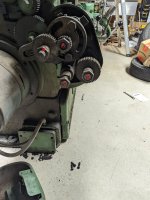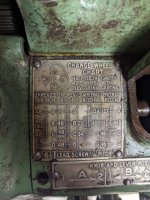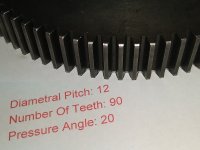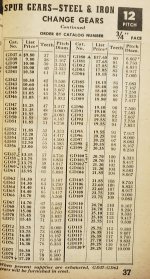I could really use some help figuring this out. I have a DSG 4AV lathe that I acquired and I've figured out (partially) why my power feed isn't working. It seems I'm missing a change gear (several actually, but only one that I NEED). In the pictures, I attached the plate that has the setups, and a picture of the gears with them labeled how I believe is correct. It seems I'm missing the gear on "C". I took the gear from "D" and moved it to "C" and now I can get my power feed screw to spin. My problem is that I cannot seem to get the correct information for the gear that I need to either make or buy.
The O.D. of the gear on "D" is approximately 105mm, and the gear on "B" is approximately 112mm. I know a Mod 2 gear is 100mm and a mod 2.25 gear is 115mm. These are 48 tooth gears but I'm unsure if they are 20 deg, 14.5 deg, or some other PA. I have some 14.5 deg gear cutters, but they are the wrong mod, so I don't know any good way to determine which gear cutter to buy.
Right now I'm just trying to get smooth sliding and surfacing cuts, but I would like to be able to make all the threads also, so any insight into what gears I need would be helpful.
If anyone has any insight into what these gears are and how I could make them (which PA/Module cutter to buy) I would greatly appreciate it. I have an arbor and dividing head and milling machine, so I can make them if I just could figure that out.
Thanks for any help!
The O.D. of the gear on "D" is approximately 105mm, and the gear on "B" is approximately 112mm. I know a Mod 2 gear is 100mm and a mod 2.25 gear is 115mm. These are 48 tooth gears but I'm unsure if they are 20 deg, 14.5 deg, or some other PA. I have some 14.5 deg gear cutters, but they are the wrong mod, so I don't know any good way to determine which gear cutter to buy.
Right now I'm just trying to get smooth sliding and surfacing cuts, but I would like to be able to make all the threads also, so any insight into what gears I need would be helpful.
If anyone has any insight into what these gears are and how I could make them (which PA/Module cutter to buy) I would greatly appreciate it. I have an arbor and dividing head and milling machine, so I can make them if I just could figure that out.
Thanks for any help!








